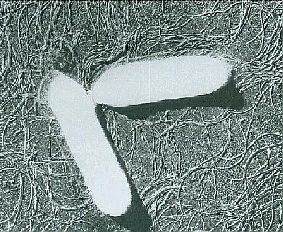Tokyo Food Safety Information Center » Good things to know » The microorganisms which cause food poisoning » Clostridium botulinum
Clostridium botulinum
Characteristics

Clostridium botulinum are an anaerobic bacteria commonly found in soils, mud and sand of seas, lakes, and rivers. Clostridium botulinum forms spores that are strongly resistant against heat. When exposed to hypoxic (low oxygen) conditions, the spores of clostridium botulinum germinate and increase, resulting in production of a neurotoxin. This neurotoxin reportedly has the strongest toxicity of currently known toxins in nature and is classified into seven types labeled A to G.
Types of botulism
Botulisms are classified into types, including (foodborne) botulism caused by consumption of foods containing toxins produced by botulinum growing in the food, and also, infant botulinum, occurring in infants.
Botulism is characterized by neurologic symptoms including nausea, vomiting, blurred vision, speech disorders and swallowing disorders, which appear 8 to 36 hours after intake of a food in which botulinum toxin has been produced. If symptoms are serious, the victim may die due to respiratory paralysis.
Infant botulinum is found in infants less than one year of age. If an infant ingests botulinum spores, the bacteria increase in the intestinal tract producing toxins which may result in symptoms of poisoning caused by absorption of the toxins. Infant botulinum symptoms include: paralysis due to muscular relaxation, constipation for several days, and weakness due to degraded muscular strength of the whole body, difficult or poor milk feeding, and weakened crying.
Which foods can cause clostridium botulinum?
In general, foods in hypoxic (low oxygen) states are likely to cause the disease. These conditions can occur in bottled, canned, container-packed and preserved foods (especially homemade foods preserved in bottles and cans). In Japan, food poisoning by fermented fish products or “izushi”, which were mainly produced in the Hokkaido and Tohoku regions, was reported until around 1997. Incidents of “izushi” caused botulism have become rare to non-existent as home-preserved foods become less common.
However, food poisoning has occurred in-packed foods (especially those that look like retort [pouch packaging made from plastic and metal foils], which may not have been heat-treated at 120° C for four minutes), bottled and homemade canned foods. If clostridium botulinum increases inside a food package, the package may expand or bulge and opening it may give out a foul smell.
Honey was sometimes a source of infant botulinum. The cases derived from honey have decreased since October 1987, when the then Ministry of Health and Welfare gave a notice that honey should not be given to infants less than one year of age. Other than honey, there have been few cases where any food causing poisoning was identified. Homemade vegetable soup was thought to be the source of infection in one case found in Tokyo.
What are the key points to preventing botulism?
Because the spores of clostridium botulinum are broadly distributed in soil, it is difficult to prevent contamination of raw food material. In order to prevent botulism, it is important to restrict the growth of the bacteria within foods.
Key points to preventing food poisoning by clostridium botulinum
-
Retort pouch foods and most canned foods are heat-treated at 120° C for four minutes and thus can be stored at room temperatures. However, commercially distributed products can have confusing appearances. Products that have no indication of “Disinfected by pressurizing and heating after stored and sealed in air-tight container” and products that have warnings such as “Keep refrigerated”, or “Keep at 10° C or less” should be kept refrigerated and consumed before their expiration dates.
-
If vacuum packs or cans look expanded or bulging, or the food gives out a foul smell (smell of butyric acid), be sure not to eat it!
-
Since clostridium botulinum spores are heat resistant, heating at 120° C for at least four minutes (or at 100° C for at least six hours) is required to completely annihilate them. Therefore, it is dangerous to preserve homemade canned, vacuum-packed and bottled foods and “izushi” without sufficiently washing the raw material and taking full caution in utilizing proper disinfecting temperatures and storage methods. For storage, allow refrigeration at 3° C or less or freezing at -18° C or less.
-
Heating foods immediately before eating can be effective because botulinum toxin, which is the direct cause of the food poisoning symptoms, becomes deactivated by heating at 80° C for 30 minutes (or at 100° C for several minutes).
- To prevent infant botulinum, avoid giving infants less than one year of age foods that can potentially become contaminated by spores of clostridium botulinum, including honey, etc.